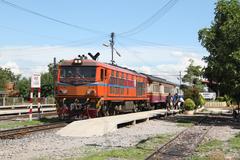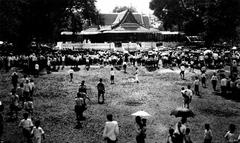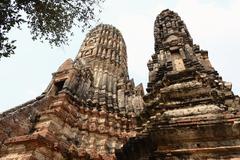
Wat Phanan Choeng: Visiting Hours, Tickets, History, and Attractions in Phra Nakhon Si Ayutthaya
Date: 04/07/2025
Introduction
Wat Phanan Choeng is one of the most iconic and historic Buddhist temples in Phra Nakhon Si Ayutthaya, Thailand. Founded in 1324 CE—nearly three decades before the establishment of Ayutthaya as the Siamese capital—the temple embodies the region’s spiritual roots, multicultural heritage, and enduring role as a center of Thai and Chinese Buddhist devotion. It is renowned for its colossal gilded Buddha, Luang Pho Tho, as well as rich legends, distinctive architecture, and ongoing religious practices. This definitive guide offers detailed information on visiting hours, ticketing, travel tips, the temple’s historical background, and nearby attractions to help you plan a meaningful visit. (Wikipedia, North of Known, Guide2Thailand, BestPrice Travel)
Table of Contents
- Early History and Cultural Context
- The Legend of Princess Soi Dok Mak
- The Colossal Buddha: Luang Pho Tho
- Chinese Influence and Zheng He’s Visit
- Architectural Highlights
- Visiting Hours and Ticket Information
- Accessibility and Travel Tips
- Nearby Attractions and Guided Tours
- Rituals, Festivals, and Community Engagement
- Frequently Asked Questions (FAQ)
- Visuals and Media
- Conclusion
- References
Early History and Cultural Context
Wat Phanan Choeng’s origins predate the city of Ayutthaya itself, established in 1324 CE by Phra Chao Sai Nam Phueng. Its riverside location at the confluence of the Chao Phraya and Pa Sak made it accessible to local settlers and foreign traders, specifically Chinese refugees from the Song dynasty. These early Chinese influences are still visible in the temple’s shrines and rituals, reflecting Ayutthaya’s role as a melting pot of cultures. The temple survived the Burmese invasion of 1767 and remains a thriving center of worship today. (Wikipedia, North of Known)
The Legend of Princess Soi Dok Mak
A poignant legend surrounds the temple’s founding: Princess Soi Dok Mak, a Chinese royal sent to marry the local ruler, drowned herself in the river after feeling slighted by her betrothed’s failure to welcome her. Overcome with grief, the prince ordered the construction of a shrine in her memory—an act believed to be the genesis of Wat Phanan Choeng. The princess’s spirit is still honored at a dedicated shrine within the temple complex, especially by those seeking guidance in matters of love and reconciliation. (North of Known, Guide2Thailand)
The Colossal Buddha: Luang Pho Tho
At the heart of Wat Phanan Choeng stands Luang Pho Tho (Phra Buddha Trairattananayok)—a majestic, 19-meter-high gilded Buddha image, among the largest and oldest seated Buddha statues in Thailand. Created at the time of the temple’s founding, the statue is both a spiritual protector and a symbol of Ayutthaya’s historical grandeur. It is revered not only by Thai Buddhists but also by the Thai-Chinese community, who know it as Sam Pao Kong. Numerous restorations, including that by King Mongkut (Rama IV) in the 19th century, have preserved its serene majesty. (Wikipedia, Thailand For Visitors, Guide2Thailand)
Chinese Influence and Zheng He’s Visit
Wat Phanan Choeng has long served as a spiritual anchor for Ayutthaya’s Chinese community. Its significance was cemented in 1407 CE, when the famed Chinese admiral Zheng He visited during his imperial voyage. He made offerings to the temple in a ceremony attended by the Siamese king, a tradition honored by Thai-Chinese devotees to this day. Shrines within the temple complex and annual Chinese festivals—such as Chinese New Year—highlight this ongoing cultural exchange. (Wikipedia)
Architectural Highlights
The Viharn (Assembly Hall) & Buddha Image
The main viharn houses Luang Pho Tho and features soaring red columns, a high gabled roof, and walls adorned with hundreds of small Buddha images. The atmosphere is both grand and intimate, accommodating large groups of worshippers during daily rituals and special ceremonies. (Backpackers Bay)
The Ubosot (Ordination Hall)
Reserved for monastic rituals, the Ubosot is decorated with murals depicting the Jataka tales and features classic boundary stones (Bai Sema), marking its sacred space.
Shrine of Princess Soi Dok Mak
This Chinese-style shrine, with its ornate roof and vibrant red-and-gold colors, stands as a symbol of the enduring bond between Thai and Chinese communities. Offerings of fruit, flowers, and incense are common here, especially during Chinese festivals. (Backpackers Bay)
Bell Tower and Auxiliary Structures
The wooden and brick bell tower, monks’ quarters, and smaller chapels round out the complex, serving the daily needs of the resident community.
Courtyards, Gardens, and Riverfront
Shaded courtyards and river views provide a tranquil setting for reflection, while guardian statues and naga serpents line the pathways, blending spiritual symbolism with artistic tradition.
Visiting Hours and Ticket Information
- Opening Hours: Daily, 8:00 AM – 5:00 PM
- Entry Fee: THB 20 per person (as of July 2025; previously free, but subject to change)
- No advance tickets required. Donations are welcome and support temple maintenance.
(BestPrice Travel, Holidify)
Accessibility and Travel Tips
- Getting There:
- By tuk-tuk, taxi, or bicycle from Ayutthaya city center (approx. 10 minutes)
- By riverboat, with a pier at the temple for scenic arrivals
- From Bangkok: Train or bus to Ayutthaya, then tuk-tuk or taxi
- Accessibility:
- The grounds are mostly flat; some areas have steps or uneven surfaces.
- Wheelchair access is possible in outer areas but limited for the main shrine (due to stairs and shoe removal).
- Dress Code:
- Modest clothing required (shoulders and knees covered). Sarongs available for rent or purchase.
- Shoes must be removed when entering main halls.
(The Jetsetter Diaries)
Rituals, Festivals, and Community Engagement
- Major Festivals:
- Chinese New Year (ancestral blessings, lantern displays)
- Buddhist holy days (Makha Bucha, Visakha Bucha)
- Rituals:
- Robe offering ceremonies for the giant Buddha
- Merit-making, chanting, and candlelit processions
- Community Programs:
- Meditation retreats, language classes, and cultural events open to visitors
- Vendor stalls selling offerings, refreshments, and souvenirs
(Passports and Photographs)
Nearby Attractions and Guided Tours
Wat Phanan Choeng’s central location makes it easy to add nearby highlights to your itinerary:
- Wat Mahathat: Famous for the Buddha head entwined in tree roots
- Wat Ratchaburana: Renowned for its prang and murals
- Ayutthaya Historical Park: UNESCO World Heritage Site with extensive ruins
- Boat Tours: River excursions often include Wat Phanan Choeng and other significant temples
- Guided Tours: Available through local operators and apps, providing historical and cultural context
Frequently Asked Questions (FAQ)
Q: What are the visiting hours?
A: Daily, 8:00 AM – 5:00 PM
Q: What is the entry fee?
A: THB 20 per person (subject to change); donations appreciated
Q: Is the temple wheelchair accessible?
A: Partially; outer areas accessible, but main shrine access limited by stairs
Q: Are guided tours available?
A: Yes, through local operators and digital platforms
Q: What is the best time to visit?
A: Early morning or late afternoon to avoid heat and crowds
Q: Is photography allowed?
A: Generally yes, but avoid flash and be respectful during rituals
Visuals and Media
- Images:
- Luang Pho Tho, the colossal gilded Buddha
- Shrine of Princess Soi Dok Mak
- Temple courtyards and riverfront views
- Alt Tags:
- Use keywords such as “Wat Phanan Choeng visiting hours,” “Ayutthaya historical sites,” “Luang Pho Tho Buddha statue,” and “Wat Phanan Choeng tickets”
- Interactive Maps and Virtual Tours:
- Enhance your planning with maps highlighting the temple’s location and nearby attractions
- Look for online virtual tours and videos showcasing rituals and festivals
Conclusion
Wat Phanan Choeng is a living testament to Ayutthaya’s spiritual, historical, and cultural richness. Its monumental Buddha, compelling legends, and cross-cultural ceremonies offer visitors a profound glimpse into the region’s past and present. Whether you are a pilgrim, a history enthusiast, or a traveler eager to experience authentic Thai culture, the temple promises an enriching and memorable journey. Plan your visit with attention to etiquette, timing, and accessibility to fully appreciate this remarkable site. For enhanced exploration, consider using the Audiala app for audio guides, itinerary planning, and festival updates.
References
- Wat Phanan Choeng, Wikipedia
- Wat Phanan Choeng: Visiting Hours, Tickets, and History, North of Known
- Wat Phanan Choeng, Guide2Thailand
- Wat Phanan Choeng Worawihan, BestPrice Travel
- Wat Phanan Choeng Visiting Hours, Klook
- Temples in Ayutthaya, Passports and Photographs
- Backpackers Bay: Tips to Visit Wat Phanan Choeng
- The Jetsetter Diaries: Ayutthaya Temples
- Holidify: Wat Phanan Choeng
- Ayutthaya2020: Wat Phanan Choeng
- The Sunrise Dreamers: Ayutthaya Itinerary



